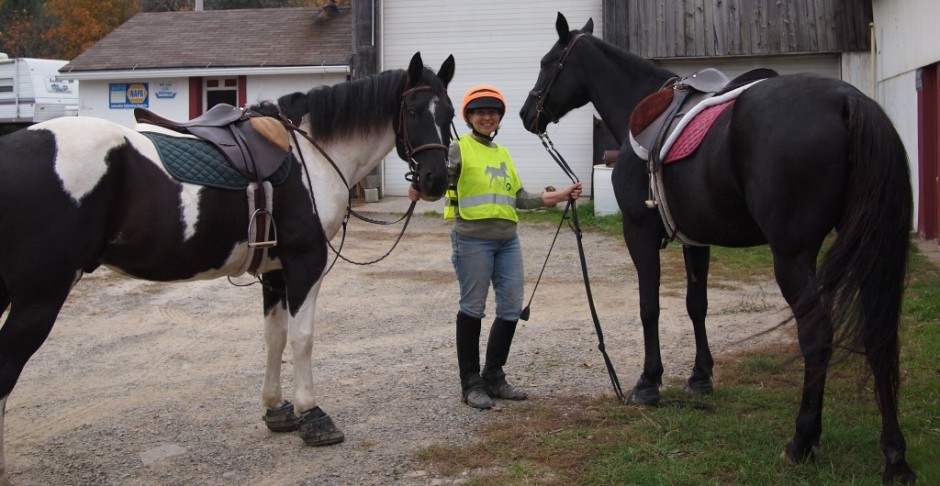Cold grey clouds covered the sky a few days ago when I saddled Pepper. I pulled on a ski mask, fitted the winter helmet cover’s strap under my chin, slipped on thick fleece lined gloves and headed up the road for an afternoon ride. Pepper briskly stepped into a quick walk, head alert and ears pointed forward. I watched the movement of her ears; every few minutes one ear then the other turned to the side or backward. She alternated her ears as if they were antenna picking up sounds I couldn’t hear. Halfway up the hill, I saw a calico cat slicking through the dried weeds near the edge of the road. Pepper sighted the cat in her peripheral vision, turned her ears and head towards the cat and instantly decided to sidestep a few paces backward.
“Pepper, it’s just a cat,” I said. “Walk past it.”
Pepper complied with my request and quickly walked past the cat which by this time had retreated further into the field. Yet her ears were on guard, rotating and turning in alternate directions attempting to pick up a predator that might be lurking in the field.
Horses have cone shaped independently mobile ears which allow them to funnel sound waves into their ear canal. The equine sense of hearing helps the horse locate sounds which aids in the horse’s survival as a prey animal. Unfortunately for riders, the horse may translate an unknown sound as “get out of Dodge as quickly as possible – ask questions later – save yourself!” Sometimes the result is a major “spook” causing the horse to buck, rear, bolt or employ some other maneuver for self-preservation. To compound the problem, the horse hears much better than we do.
Researchers have discovered that horses hear about 2/3 of an octave higher than humans. Although the horse can hear higher pitched noises, they are not very good at localizing sounds. Often they point their ears forward or rotate their ears to search for the location of the noise. Horses rely heavily on their vision to locate danger. Since horses can see almost 360 degrees around themselves their ears don’t have to be that accurate in pinpointing the sound’s exact location. Once the horse hears a noise, the animal turns his head to see where it is coming from. Generally, horses don’t stop to analyze a scary situation; instead they run away to a safe distance then turn around to see what spooked them.
A couple of weeks ago, I rode Pepper on a very windy day. The gusts blew up to 15 mph and the wind was so loud it was hard for me to hear. Pepper from the start was nervous, often turning her head to look at branches moving in the wind. Plastic tarps and bags blown by the wind startled her. Pepper couldn’t hear very well and that made her jumpy. Since her hearing was limited she had to rely on her vision.
The wind whipped through the valley, across open fields and along the ridges on Round Top Mountain. High winds are not uncommon here, especially in spring. I rode down one hill with no wind blowing at all, no sound, everything still. A ridge or stand of trees blocked the wind, forming a solid barricade, a wall which held back the airstream. Then suddenly, Pepper and I turned a corner and a blast of cold air hit us dead-on. The wind roared so loud it sounded like a truck barreling at full speed down the road. Several times I looked back just to make sure it was only the wind and not something else headed our way.
Pepper and I returned to the stables. I unsaddled the horse and brushed her down. Inside the barn we heard the roar of the wind beating on the outside of the barn. There were other sounds mixed with the wind which I couldn’t distinguish. Of course Pepper’s hearing was better than mine. I really didn’t hear whatever it was that made her pick up her head, prick her ears and listen.
“It’s ok girl nothing’s going to eat you today,” I told her in a reassuring voice.
I walked outside and stopped for a moment. The dark of night was about to fall. I listened to the lonely howl of a pack of coyotes some distance off in the woods near Murray Creek. The howls lifted into the air and were carried away on the wind. Quickly, I opened the car door, climbed in and locked the door. ‘Maybe Pepper knows something I don’t,” I thought as I started the car, pulled away from the barn and headed home.
Sources:
http://www.equinechronicle.com/health/hearing-in-horses.html; http://www.equisearch.com/horses_care/health/anatomy/eqhearing933/; http://www.petcaregt.com/blog/how-do-horse-hear.html
Copyright © 2013 Patricia Miran All Rights Reserved
